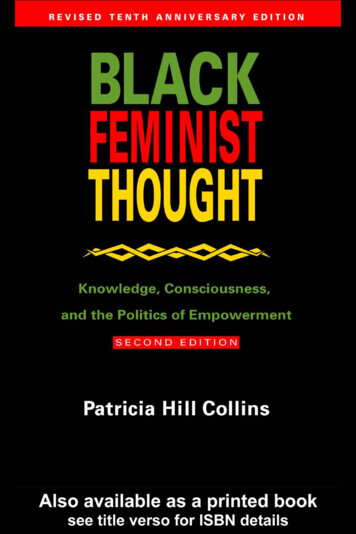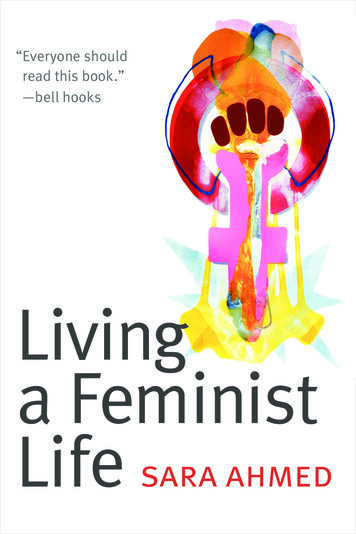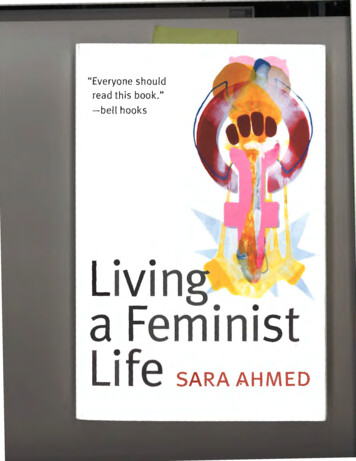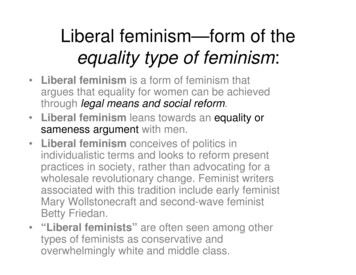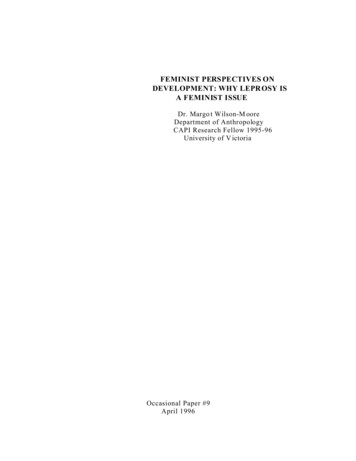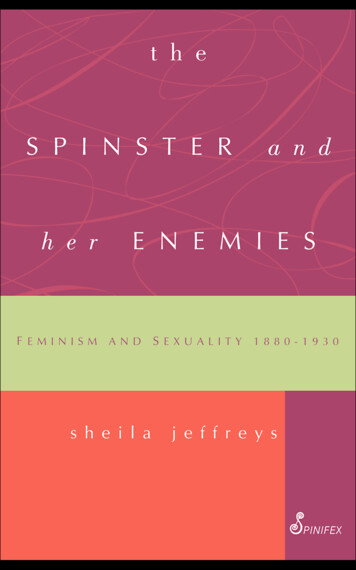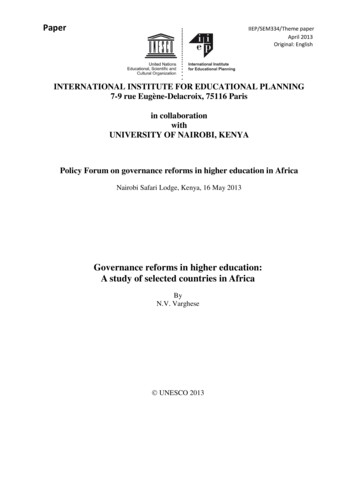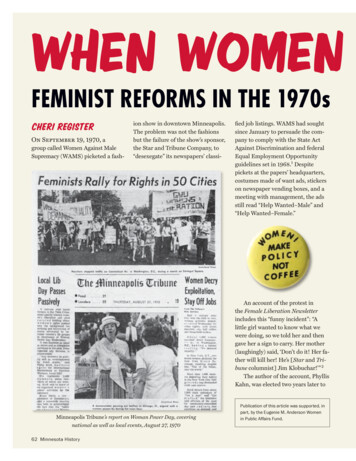
Transcription
When WomenFeminist Reforms in the 1970sCheri RegisterOn September 19, 1970, agroup called Women Against MaleSupremacy (WAMS) picketed a fash-ion show in downtown Minneapolis.The problem was not the fashionsbut the failure of the show’s sponsor,the Star and Tribune Company, to“desexegate” its newspapers’ classi-fied job listings. WAMS had soughtsince January to persuade the company to comply with the State ActAgainst Discrimination and federalEqual Employment Opportunityguidelines set in 1968.1 Despitepickets at the papers’ headquarters,costumes made of want ads, stickerson newspaper vending boxes, and ameeting with management, the adsstill read “Help Wanted–Male” and“Help Wanted–Female.”An account of the protest inthe Female Liberation Newsletterincludes this “funny incident”: “Alittle girl wanted to know what wewere doing, so we told her and thengave her a sign to carry. Her mother(laughingly) said, ‘Don’t do it! Her father will kill her! He’s [Star and Tribune columnist] Jim Klobuchar!’ ” 2The author of the account, PhyllisKahn, was elected two years later toMinneapolis Tribune’s report on Woman Power Day, coveringnational as well as local events, August 27, 197062 Minnesota HistoryPublication of this article was supported, inpart, by the Eugenie M. Anderson Womenin Public Affairs Fund.
Went Publicthe Minnesota House of Representatives, becoming one of an unprece dented six female legislators. Sheserves there still, among 43 womenin a body of 134. In 2006 the “littlegirl,” Amy Klobuchar, became thefirst woman elected to the U.S. Senate from Minnesota. Neither featwould have been likely without theconsciousness-raising, organizing,demonstrating, and lobbying thatmade the 1970s, in the words of University of Minnesota history professor Sara M. Evans, the “golden years”of the women’s movement.3 Changeswrought in that decade opened virtually all arenas of civic life to women.Minnesota became a nationalproving ground for feminist reforms.The first battered women’s shelter inthe country was established here, aswell as the first pay equity programin public employment. Minnesota’shigh rate of volunteerism and thebipartisan civility of its machine-freegovernment made the passage of citizen initiatives into law an achievablegoal. Decades later, it is well worthexamining how Minnesota womenaffected landmark changes that wemay today take for granted.“Don’t iron whilethe strike is hot!”Three weeks before the WAMSprotest, on August 26, 1970, womenhad massed in downtown Minneapolis to mark the fiftieth anniversaryof the Nineteenth Amendment tothe U.S. Constitution, which grantedMinneapolis’s Foshay Tower, deckedout for Woman Power Day, 1970them the right to vote. The NationalOrganization for Women (NOW)urged women to skip work andhousehold tasks that day: “Don’t ironwhile the strike is hot!” In response,the Women’s Advisory Committeeto the Minnesota Department ofHuman Rights organized “WomanPower Day,” featuring leading localwomen giving speeches and workshops on employment, education,politics, youth, and economics.A sign of the times, the brochurelisted, for example, future judgeDiana Murphy, then president of theLeague of Women Voters, as “Mrs.Joseph Murphy, Jr.” 4I headed downtown full of excitement. I knew of plans for guerrillatheater and eating lunch “unaccompanied” in men-only dining rooms,chief among them Dayton’s Men’sOak Grill. I kept my eye on the Foshay Tower, the city’s tallest building, and soon a bed-sheet bannerunfurled from the observation deck,reading “WOMEN UNITE.” A selfstyled radical feminist of 25, I wasskeptical of the program that the“nice ladies,” Republican GovernorHarold LeVander’s appointees to theWomen’s Advisory Committee, haddesigned. Indeed, the workshop oneconomic power focused on investment and banking. Where, I asked,were women to get money to investif their jobs paid them an average of57 cents to a man’s dollar? A panelistadmonished me to be patient: “Youyoung women are in such a hurry toget that fur coat.” Yet our encounter,and others that day, helped establisha symbiosis between nice ladies andradicals. As Nina Rothchild now describes it, “There was an understanding that you need people far out,rocking the boat, and then the niceladies come in, and they’re solving aproblem. In the meantime, you shiftthe center towards the direction youwant to go.” 5 The nice ladies put ontheir power pantsuits and headedfor the state capitol. The boat rock-Cheri Register is a cofounder of theEmma Willard Task Force on Education and a pioneer in the field of women’s studies. A writer with several booksin print, she teaches creative-nonfictionwriting at the Loft Literary Center.Summer 2008 63
ers found ballast for their outrage incountercultural models of change:women’s health clinics, rape crisiscenters, feminist theaters, and more.EMPLOYMENTVivian Jenkins Nelsen remembersthat August 26 commemorationand wondering whether black suffragists would be duly celebrated,but she was too busy at her new jobto attend. As director of financialassistance for the minority education program at Augsburg College,she was responsible for 52 students.Two other new hires—a man and awoman—joined her at the same rankin the same department.One day when her male colleague was away, Nelsen answereda phone call from a car dealership.The caller was checking whether theman worked full-time. “And does hemake 12,000?” “I hope to hell not,”Nelsen blurted and hung up. She toldher female colleague, who, like her,earned 9,000, and they figured hehad inflated his salary to get financing. Weeks later when one of herstudents—Syl Jones, now an editorialcolumnist for the Star Tribune—discovered that Augsburg’s few facultywomen earned less than their malecounterparts, the phone call madesense. “We didn’t just leap off into thewomen’s movement,” Nelsen explains.“I took it like, well, they’re Lutheranand they don’t know any better. Iwas raised in a Lutheran church. Iknew that it had been very shieldedfrom people of color and such, soI cut them a little slack.” Later thepay differential was explained at afaculty meeting: Men needed moremoney because they were heads ofhouseholds. Nelsen, meanwhile, wasthe primary breadwinner while herhusband looked for a job. “The nickeldropped,” she says, and the womenfiled a complaint in 1971.Yet passage of alaw did not al wasa common sequence of reactions forworking women who trusted in the1963 Equal Pay Act, the 1964 CivilRights Act, and the Equal Employment Opportunity Commission toprotect their interests. Yet passage ofThe Narr ator sEleven women, all active feminists in the 1970s, were interviewed forEach stands for scores more who also have much to tell.Linda Bergli n , elected to the Min-Carol Lacey, formerly a reporternesota House of Representatives in1972 and now serving in the stateSenate.for the St. Paul Pioneer Press andDispatch, now teaching at Metropolitan State University.Mary Ann Grossmann, formerVivian Jenkin s Nelsen , onceeditor of the women’s pages ofthe St. Paul Pioneer Press andDispatch, now the Pioneer Pressbook review editor.state president of the Women’sEquity Action League, now the executive director of the Inter-RaceInstitute.Paulette Joyer, former viceGerri Perreault, cofounder ofpresident of Minnesota Feminists forLife, now an attorney working with theelderly.Phylli s Kahn, cofounder of theMinnesota Women’s Political Caucus,who has served in the state House ofRepresentatives since 1972.64 Minnesota Historythe Emma Willard Task Force on Education, now Director of LeadershipStudies at the University of NorthernIowa.Nina Rothch ild, the first directorof the Minnesota Commission onthe Economic Status of Women, nowthis article.retired but on the board of the Minnesota Women’s Consortium.Emily Anne Staples Tuttle ,chair of the first Minnesota Women’sAdvisory Committee, elected to thestate Senate in 1976, now serving onnonprofit boards.Sharo n Rice Vaughan, memberof Women’s Advocates and pioneerin securing justice for batteredwomen, now an associate professorat Metropolitan State University.Nancy Regist er Wange n, activein the statewide enforcement ofequity in education, now retired fromthe Minnesota State Colleges andUniversities.
a law did not guarantee enforcement.Phyllis Kahn, a researcher in genetics and cell biology at the Universityof Minnesota, had filed a complaintabout job status and pay with theuniversity’s judiciary committee in1968 that incited acts of retaliation.She appealed to the EEOC, only tohave the complaint sit unsettled for adozen years.6Nelsen’s case moved along, however. She got involved in the Women’s Equity Action League (WEAL),which she calls “the legal arm of thewomen’s movement.” Attorney EllenDresselhuis, the local president,championed litigation. MinnesotanArvonne Fraser, then known as thewife of Congressman Donald Fraserand founder of the D.C. chapter ofWEAL, worked through channels inCongress with her WEAL colleagueBernice Sandler to get wordingadded to the Education Amendments of 1972.7 Title IX, as it cameto be known, read, “No person in theUnited States shall, on the basis ofsex, be excluded from participationin, be denied the benefits of, or besubjected to discrimination underany education program or activityreceiving federal financial assistance.” Even Augsburg, a private religious college, fell under this rule.Nelsen moved to the Universityof Minnesota in 1972. The followingyear, researcher Shyamala Rajenderfiled a discrimination complaintagainst the chemistry department.WEAL offered assistance, and a lawfirm took the case as a class-actionsuit. The Rajender Decree, issued in1980, standardized hiring practices atthe university and awarded salary increases to covered female employees.8The early high-profile discrimination cases tended to be in academeor at management levels of business,or they secured employment for the“first” in a traditionally male field.Later in the decade, conditions facedby working-class women in “female”jobs would come to the fore.EDUCATIONArvonne Fraser, who championedpay equity and equal opportunityin education, about 1970Woman Power Day brought focus tomy activism. Over lunch in the menonly section of Powers departmentstore’s basement dining room, I gotto know Gerri Helterline (later Perreault) from NOW.9 We both foundspeaking about women’s liberationto high-school classes on the “freakof-the-week circuit” to be redundantand ineffective. We wanted to reachyounger children not yet socializedinto stereotypical roles and to address inequities through revampedcurricula and egalitarian classroommethods. We would eliminate the re-quirement that girls take home economics and boys take industrial arts,include women in history texts andfemale writers in English courses,and encourage girls’ interest in science and athletics. By February 1971we, with three like-minded women,formed the Emma Willard TaskForce on Education, named for thefounder of the nation’s first secondary school for girls.10We laid out our concerns in aletter to Howard Casmey, the statecommissioner of education, andcopied Wenda Moore, an assistantto Governor Wendell Anderson.11Moore arranged a meeting for us inthe governor’s office with Don Hadfield, the Equal Opportunities officerin the Department of Education. Thedepartment had recently issued EDU521, a mandate that all teachers takea course in human relations for certification or recertification. Althoughit was meant to raise awareness ofracism, Hadfield would consider applying it to sexism. We continued tomeet with him in a fashion peculiarto the time: Since “women’s libbers”aroused snickers in the halls of government, Hadfield served us doughnuts at his home.As a result, the Emma WillardTask Force presented EDU 521workshops at every opportunity.Gerri Perreault learned to read thecaptive participants’ moods, and shepreferred hostility to indifference:“It meant you might reach them,because at least they were engaged.”To enlarge our audience, we printeda collection of materials, Sexism inEducation, in December 1971. Tenyears later we were still filling ordersfrom as far away as Australia. Welearned strategy by trial and error.Perreault remembers an instancewhen bypassing an administrator tomeet with more sympathetic staffersSummer 2008 65
made the man angry. “I learned to bemore thoughtful about when I woulddo that,” she says, “because it couldburn bridges.” We formed allianceswith teachers like Mary Tjosvold,founder of Twin Cities-based Teachers for Change, and officials like NinaRothchild of the Mahtomedi schoolboard, who was organizing the fewwomen on Minnesota school boards.Perreault, Tjosvold, and Rothchildwent on to serve on a state task forceconvened in January 1974 to “eliminate sex bias in education.” 12Inspired by the Emma WillardTask Force, Nancy Wangen, a former Hopkins High School Englishteacher, began organizing meetingson Title IX. Shortly, the district hiredher to develop a policy. She first metwith each school principal to examine the implications of the law. “Inone of these interviews, the principalsaid to me after listening to my opening spiel, ‘Now what is this again?’These were people who had somehuman rights training around theissue of race, but the issue of genderjust wasn’t in the forefront. It wasmuch more threatening because theydidn’t have a lot of kids of color—hardly any, in fact—but, boy, did theyhave a lot of females.” Mary Peek wasdoing similar work in Mahtomedi,and by 1975 the two were in demandfor contract work with districtsaround the state in danger of losingstate funds unless they drew up com-66 Minnesota HistoryLeague of Women Voters lobbyists waiting to testify, 1972pliance plans. This “suburban mom”and “white-haired grandmother”quickly discovered how to persuadetheir audience—get the men to boastabout their daughters.13 “They couldsee these things for their daughterseven when it scared the daylights outof them to think about their wives,”Wangen says.for a job in the Nixon administration.The meeting concluded with plansto organize a bipartisan NationalWomen’s Political Caucus.15POLITICSLegislation, once enforced, demonstrably changed behavior. Somewomen put to use lobbying skillslearned in their work with theAmerican Association of UniversityWomen, Junior League, or PlannedParenthood. At a special Women’sDay at the Capitol on February 2,1971, we novices saw how frustratingit was to plead with uncomprehending male legislators. Electing womento office became paramount.14In July 1971 CongresswomenBella Abzug (New York), Shirley Chisholm (New York), and Patsy Mink(Hawaii) called a meeting to discusswomen’s participation in politics.Among the women who turned outwere Arvonne Fraser and RepublicanEmily Anne Staples, chair of Minnesota’s Women’s Advisory Committee,who was in Washington to interviewPoster, about 1982: “Women hold 43%of Minnesota out-of-the-home jobs,yet only 7% of its political jobs.”Phyllis Kahn and Diane Fass ofRochester agreed to spearhead aMinnesota chapter and scheduled arally over the lunch hour on August26, 1971, at NSP Plaza in Minneapolis. Besides Fraser and Staples, StateDemocratic-Farmer-Labor Chairwoman Koryne Horbal and State
Republican Chairwoman Lu Stockeraddressed the crowd. An organizing meeting in November provedsomewhat contentious, especiallyover how broadly to define “political.” The riot at the 1968 Democraticconvention in Chicago, plus the lingering war in Vietnam, had left manyfeminists disenchanted with partypolitics. Party activists prevailed,however, and strengthened theirresolve. An early draft of the bylawssays that the Minnesotan Women’sPolitical Caucus (MWPC) will “encourage” women to run for office.16“Encourage” soon gave way to “recruit, support, and endorse.”The MWPC was by design nonpartisan, but women also soughtgreater influence within the parties. Following a 1971 study, “DFLWomen: Present but Powerless,” Koryne Horbal and others drove fromcounty to county, enrolling women ina group known by 1973 as the DFLFeminist Caucus. In June 1973 some60 women, with Ann O’Loughlin’sleadership, formed the GOP Womenfor Political Effectiveness, renamedthe GOP Feminist Caucus in 1975.17Organizing bore fruit in the 1972election. Five women—two Republicans and three Democrats—joinedthe lone female incumbent, DFLerHelen McMillan of Austin, in thestate House of Representatives. Republican women had gathered inEmily Anne Staples’s living room,where Mary Forsythe of Edina announced her intent to run. ErneeMcArthur of Brooklyn Center wasthe other victorious Republican.Staples herself was maneuvered outof party endorsement at the lastminute. (Although the ballot didnot identify legislative candidates byparty, endorsement brought fundsand volunteers.) When Staples waselected to the state Senate in 1976,the DFL endorsed her.18 She hadswitched parties in 1973, one yearafter serving on the platform committee for a state GOP convention.“We put forward a platform thatcertainly supported the Equal RightsAmendment and freedom of choicefor women. There was lots of wrangling on the floor and they did notpass either [one]. I think there wereeight of us who at that point said,‘I don’t think this is our party anymore.’” The GOP had begun a momentous shift to the right.A statewide reapportionment thatcreated new districts with no incumbents benefited the three DFL winners. Linda Berglin claimed a newseat in South Minneapolis. When shelearned that her district in SoutheastMinneapolis was open, Phyllis Kahnbecame, she says, “a victim of myown rhetoric” and contemplated running. Her decision was sealed whenher dean at the university told herthat because of her discriminationcomplaint, he would not endorse herfull request for research funds.The campaign woulddraw on female networks:carpools, PTA, bookclubs, coffee parties.A campaign that continues todraw national notice took place inMinnetonka, a Republican stronghold.19 Nancy Wangen, the DFLchairwoman in a district with noincumbent, was asked to run, but shehad young children and a reputationas quite liberal. She suggested JoanGrowe, whom she had met in theLeague of Women Voters. Wangenand Gretchen Fogo, another teachertaking time out to raise children,cochaired Growe’s campaign. “I remember the first meeting at Joan’sState Senator Emily Staples, cutting a shamrockcake with DFL colleagues Nicholas Coleman andEdward J. Gearty, about 1978house when we talked about strategy,” Wangen says, “and one of themen said, ‘Well, the first thing weneed to do is a door-to-door canvassto find where the Democrats are.’After they left, I said to Joan, ‘Scrubthat.’ ” The campaign would drawon female networks: carpools, PTA,book clubs, coffee parties. Weeklymeetings in the basement of St.Luke’s Presbyterian Church, withchildcare, drew women with littleexperience in politics. “We had realtasks at those meetings. It wasn’t justcome and stuff envelopes.” The campaign proved empowering for its coreparticipants, several of whom wenton to graduate or professional school.Because the GOP planned a vigorous campaign to unseat Growe inthe 1974 election, she filed insteadfor secretary of state, an office neverbefore held by a woman. She servedthere for 24 years.Summer 2008 67
YOUTHFeminists were eager to see whetherelecting women would yield tangibleresults. Charlotte Striebel, an assistant professor of mathematics atthe University of Minnesota, wasone of the first to test the new legislators’ power. Striebel had alreadyembarked on a crusade that wouldhave dramatic consequences. Herdaughter, Kathy, a swimmer, wantedthe same opportunities her brotherenjoyed, but her St. Paul junior highschool offered no girls’ sports. Evenafter she rounded up enough others,the school refused to organize a girls’swim team. St. Paul had just passedan ordinance prohibiting sex discrimination in education, so Striebelfiled a grievance in 1971, and Kathywas admitted to the boys’ team. Interschool competition raised new obstacles, some of them humiliating.20Striebel appealed to newly electedPhyllis Kahn, whom she had introduced to WAMS, and together theywrote a bill mandating coed sportsuntil athletes reached the age whensize and strength made a difference,and then equal access and fundingfor boys’ and girls’ teams. The lawthat passed in 1975 eliminated thecoed requirement to achieve equalaccess for girls of all abilities and exempted gate receipts from the funding formula.21 Passage of the athleticsbill is one of the greatest challengesKahn has faced in her legislative ca-68 Minnesota Historyreer. “People feel very emotional,” sheexplains. “That was considered sucha male province.”In a contest for symbols of changein the 1970s, a gleeful young womanpulling herself out of a swimmingpool with strong arms, wearing anefficient tank suit, her hair slickedback like an otter’s, would be a strongcontender.Fair media coveragewas as important tothe women’s movementas political power.MEDIAFair media coverage was as important to the women’s movement aspolitical power. The mainstreammedia’s preference for sideshowappeal—most famously, spuriousbra-burnings—made substantivereporting tricky to achieve. GerriPerreault points out that when shedropped her married name, the storymade page one—above the fold—ina paper that never covered the workof the Emma Willard Task Force.The late syndicated columnist MollyIvins worked briefly at the Minneapolis Tribune and was a familiarpresence at feminist gatherings.In 1970 she attended a meeting of“dissident overground journalists”that discussed two strategies fordeepening the coverage: “Many of usagreed that rather than writing aboutWomen’s Liberation, we should startwriting about the reasons why thereis such a movement—start writingabout salary discrimination, limitation of opportunities for advancement . . . and about a zillion othersubjects.” The second strategy was“sneaking” stories into the women’ssection where “no one expects anything controversial.” 22Those were precisely the strategies at St. Paul’s Pioneer Press andDispatch. Women’s section editorMary Ann Grossmann pared back thesociety news to make way for substantive articles about women’s issues.On divisive matters like abortion, shetook care to balance the coverage. “Ioften felt like I was the minefield,” shesays. “And this was so under the guys’radar—the editors’—that they didn’teven pay any attention.”Grossmann assigned reporterCarol Lacey to a women’s movementbeat, which gave her both the “contacts” and the “context” for quality reporting. Lacey remembers being theonly woman on the floor of the Minnesota Senate when it voted to ratifythe Equal Rights Amendment in1973. “The male reporters came up tome and said, ‘What is this all about?’How could you not know what thiswas about? There were women in
the state House, but there were nowomen in the Senate at the time.”Local feminists learned that the keyto media attention was “call CarolLacey.” Asked if they felt beleagueredby all the requests, both women saysimply, “We covered it.”VIOLENCE AGAINST WOMENWoman Power Day had neglectedsome vital issues, including rape,a trauma that women were finallygrowing bold enough to reveal. Somehad never reported rape, knowingthat a trial scrutinized the victim’scharacter and behavior and lookedfor complicity: whether she haddressed “provocatively,” was sexuallyactive, or ventured out alone.After a rape in uptown Minneapolis in 1971, three women starteda rape crisis center in the neighborhood.23 Others followed. Feministadvocates accompanied victims tothe hospital and to court and lobbied for public responsibility. InFebruary 1974 three members of theall-male Senate introduced a bill toallocate pilot funds for counselingand medical costs for victims, as wellas sensitivity training for police andprosecutors. The bill’s compositionshows a feminist hand: It grants authority to voluntary rape-crisis workers to conduct the counseling andtraining and recommends that peopleaiding victims be of the same gender.Despite the “sniggering” and “snideremarks” that Nina Rothchild recalls,the bill passed both houses in justover a month. In the House the word“rape” was replaced with “sexual attack,” to switch the onus from victimto perpetrator. Some credit the latePeggy Specktor with this idea, as wellas the intense lobbying that won overall but two senators. Specktor becameDirector of the Minnesota Programfor Victims of Sexual Assault.24One day a constituent notifiedRepresentative Linda Berglin aboutthe outcome of her rape charge. Shefelt that the rapist’s sentence was fartoo slight for the injury she had suffered. “So I looked into it,” Berglinsays, “and discovered the mess wehad—archaic laws that would notmeet the standards of the day interms of best practices.” She took theissue to Phyllis Kahn and they agreedto work on it together. “Neither oneof us had any law enforcement orcriminal justice background.”State Representative LindaBerglin, about 1973Ann Alton from the HennepinCounty Attorney’s office, who prosecuted rape cases, drew up a graduated schedule of degrees of sexualassault, ranging from unwantedtouch to forced penetration. If ajury hesitated to convict on the fullcharge, they might consider a lesserone. As a measure of the public reluctance to take sexual assault seriously, Berglin tells how her proposalof a mandatory three-year sentencefor a second offense horrified somemale colleagues who thought her“anti-libertarian.” Nevertheless, thesexual assault bill passed in 1975,with a clause eliminating the complainant’s previous sexual conduct asa factor in the jury’s decision. It includes Berglin’s second-offense provision but offers an option of treatmentfor “antisocial sexual behavior.”25A secret even more suppressedthan rape was gradually coming tolight: battering. A consciousnessraising group in St. Paul, eager totake on an action project, invitedDelores Orey, the only female attorney at Ramsey County Legal Assistance, to talk to them. Orey oftengot inquiries about legal separationfrom women who did not want tofile for divorce but were looking fora temporary place to stay. She toldthe group that she could use helpanswering these calls and findinghousing—no easy task, since onlyone St. Paul shelter, the Grand Hotel,admitted women and children, and itclosed in the daytime.The women who called for helpoften had other needs, as well, sothe volunteers held a weekend retreat to talk about putting together apackage of services. As Sharon RiceVaughan remembers it, “a big fighterupted there.” Some in the groupsaw themselves as “clear-thinking”advisors equipped to tell a woman incrisis what to do. Others believed thewoman knew best what she neededand should guide the process. Theyvoted and agreed to ask callers whatSummer 2008 69
more they wanted. “That sounds sosimple,” Vaughan reflects, “but it waspretty radical.” Having defined theirrole as advocacy, the women namedtheir group the Women’s Advocates.From then on, when a woman called,“You get your cup of coffee and you’reready to listen to her. You don’t haveto hurry and get off the phone. Youfind out what it is that’s really goingon with her. And that’s when womenstarted talking about being battered.”Learning why so many womenneeded emergency housing andhow vulnerable they were withoutit set the Women’s Advocates on acampaign for resources. In the meantime, Vaughan took battered womeninto her home. Within 18 monthsshe housed 115 women and children.Many appeals to local foundationsand a pledge drive among feministsfinally yielded funds to buy and rehabilitate a flea-ridden former commune on St. Paul’s Grand Avenue.The Women’s Advocates shelter forbattered women opened on October10, 1974, the first in the nation.26Senator Robert Lewis of St. LouisPark offered to seek state financingif women working on domestic violence would help draft a bill. PhyllisKahn would be the House sponsor.Passed in 1977, the law established apilot program of emergency sheltersaround the state, plus education “topromote public and professionalawareness of the problems of battered women.” 27 Programs for victims of sexual assault and batteringwere housed in the Department ofCorrections, affirming that thesewere crimes of violence, not relationships gone awry.Representative Phyllis Kahnat a meeting, about 1975To be charged as a crime, battering had to be witnessed, and children could not testify. The DomesticAbuse Act of 1979 created a newremedy, the order for protection,which allowed a petitioner to file anaffidavit alleging abuse and to ask forrelief, including barring the abuserfrom the premises.28 Vaughan ispleased to have helped secure thischange as a member of the legislative committee of the Consortiumon Battered Women, where the planoriginated. “I think the order for protection is a jurisprudential miracle,”she says, “because it allowed a crimeto be charged without having to beproved. Basically it was about believing women. It was about having thisinstitution stand up for women—both the police and the courts.”ECONOMICSEconomic inequities abounded wellinto the 1970s. Married women couldnot get credit in their own names70 Minnesota Historyuntil mid-decade, when federaland state laws declared otherwise.Widows who had farmed with theirhusbands paid inheritance tax untila tax court exempted half the land.Insurers could refuse maternity benefits to unmarried women until thelaw was tweaked in 1976. Oversightof these problems and their remediesfell to the Council (later Commission) on the Economic Status ofWomen, created by the legislature in1976.29 Nina Rothchild became itsfirst executive director. “There arenot many jobs to be a paid feminist,”she laughs. Rothchild had not beenemployed since before marriage, butshe was active in community serviceand politics. She had been lobbying at the legislature since CharlotteStriebel asked her to testify aboutgirls’ athletics. Her hiring validatedvolunteerism as legitimate work
a symbiosis between nice ladies and radicals. As Nina Rothchild now de-scribes it, "There was an understand-ing that you need people far out, rocking the boat, and then the nice ladies come in, and they're solving a problem. In the meantime, you shift the center towards the direction you want to go." The nice ladies put on


